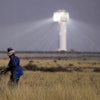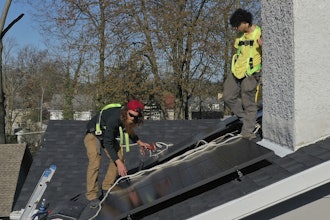The economic stimulus of 2009 was partly supposed inject a little nitrous oxide into the burgeoning green energy sector. And judging by prior performance—a wealth of new turbine farms in Texas and solar energy in the Southwest—made possible through healthy profits by utilities and favorable tax credits, the future would be only slightly slowed by the Great Recession.
But the jury's still out on whether green energy is the future of U.S. jobs. And we’re still not sure which green jobs those will be.
News that BP will shutter its last U.S. solar plant comes a short while after an announcement by A-Power Energy Systems that their new wind turbine factory in Nevada would create 1,000 jobs. The up-and-down news highlights the big differences between these energy sectors.
Wind turbines are large, complex mechanical installations that are more cost-effective to produce in the country where they'll be used. Siemens, for example, recently said they would be investigating the possibility of a big turbine manufacturing plant in the UK as a way to capitalized on anticipated demand for wind energy in that country.
However, wind turbines are subject to the volatility of certain commodities, and the investment plateau is much higher. Then there’s the maintenance on a 300-foot-tall rotor-gearing mechanism.
Solar cells, meanwhile, while comparatively cheap, have butted up against an efficiency barrier. Breakthroughs in recent years have depended on highly-customized architectures—delicate nanostructures—or expensive materials—indium and gallium. The conventional amorphous or crystalline silicon solar cell module, meanwhile, has plummeted in price. Demand initially encouraged companies to get into the business big time, but in the long-run they’ve been hurt by low prices. Hence, the quest begins for cheaper labor.
I don’t think this is necessarily a bad thing. Solar cell technology will continue to change, and silicon is not exactly the greenest manufacturing method around. Wind turbines, meanwhile, are complex machines with a level of technology that demands higher skills to go with the higher wages. Owning expertise in wind energy—from gearing manufacture, to blade materials, to smart grid technologies—is definitely a long-run plus for the U.S.
Solar will continue to grow. The existence of schemes like feed-in tariffs, which cities like Los Angeles are considering to stimulate their uptake of solar energy, will guarantee. But the notion that solar or wind will in the short term overtake other energy sources is fiction: the recent announcement to allow expansion of domestic coastal oil-drilling is evidence of that. (Ed: This column was written before the oil rig disaster in the Gluf of Mexico was fully realized — there may be hope for solar and wind yet!)
But despite the costs, the future seems bright for wind energy. If we can support the investment necessary to build a networked system of wind turbines, such as one proposed recently for the East Coast, we might not have to drill for oil there.


















